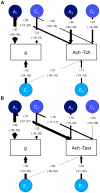Added value measures in education show genetic as well as environmental influence
- PMID: 21311598
- PMCID: PMC3032733
- DOI: 10.1371/journal.pone.0016006
Added value measures in education show genetic as well as environmental influence
Abstract
Does achievement independent of ability or previous attainment provide a purer measure of the added value of school? In a study of 4000 pairs of 12-year-old twins in the UK, we measured achievement with year-long teacher assessments as well as tests. Raw achievement shows moderate heritability (about 50%) and modest shared environmental influences (25%). Unexpectedly, we show that for indices of the added value of school, genetic influences remain moderate (around 50%), and the shared (school) environment is less important (about 12%). The pervasiveness of genetic influence in how and how much children learn is compatible with an active view of learning in which children create their own educational experiences in part on the basis of their genetic propensities.
Conflict of interest statement
Figures



References
-
- Machin S, Vignoles A. Report No. Centre for the Economics of Education;; 2006. Education Policy in the UK.57
-
- Raudenbush SW. What are value-added models estimating and what does this imply for statistical practice? J Educ Behav Stat. 2004;29:121–129. doi: 10.3102/10769986029001121. - DOI
-
- Thomas S, Peng WJ, Gray J. Value added trends in English secondary school performance over ten years. Oxford Rev Educ. 2007;33:261–295.
-
- McCaffrey DF, Lockwood JR, Koretz D, Louis TA, Hamilton L. Models for value-added modeling of teacher effects. J Educ Behav Stat. 2004;29:67–101. doi: 10.3102/10769986029001067. - DOI - PMC - PubMed
-
- Boomsma D, Busjahn A, Peltonen L. Classical twin studies and beyond. Nat Rev Genet. 2002;3:872–882. doi: 10.1038/nrg932. - DOI - PubMed
Publication types
MeSH terms
Grants and funding
LinkOut - more resources
Full Text Sources

